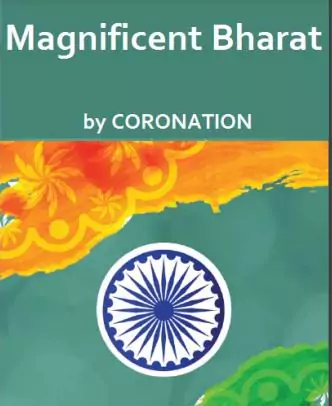‘Magnificent Bharat Book’ PDF Quick download link is given at the bottom of this article. You can see the PDF demo, size of the PDF, page numbers, and direct download Free PDF of ‘Magnificent Bharat Book’ using the download button.
Magnificent Bharat Book PDF Free Download

Magnificent Bharat Book
ancient civilizations
The Indus Valley Civilization, which flourished around 2500 BC, is one of the oldest known urban civilizations in the world. Its advanced urban planning, sanitation systems, and trade networks astound historians. The remains of this ancient civilization can still be discovered in sites such as Mohenjo-Daro and Harappa.
Mughal dynasty
The Mughal dynasty, which lasted from the early 16th century to the mid-19th century, is often referred to as India’s “Golden Age”. Emperors like Akbar, Shahjahan, and Aurangzeb left an indelible mark on the cultural and architectural landscape of India. A UNESCO World Heritage Site and one of the Seven Wonders of the World, the Taj Mahal stands as a testament to the genius of Mughal architecture.
British Raj
The British Raj, which lasted for almost two centuries, brought significant changes in India. While it had a lasting impact on the country’s infrastructure and governance systems, it was also a period of intense struggle for independence led by iconic figures such as Mahatma Gandhi. India finally gained independence in 1947, ending colonial rule.
cultural kaleidoscope
India is a mix of cultures, languages, and traditions. With over 1,600 languages and dialects spoken across the country, it is a linguistic paradise. From the grandeur of Diwali, the festival of lights, to the vibrancy of Holi, the festival of colors, India’s festivals are a sensory delight. The cuisine is a gastronomic journey with regional specialties like biryani, dosa, and butter chicken.
Languages and dialects
he linguistic diversity of India is unique. Hindi with its numerous dialects is the most widely spoken language. But every state has its own official language, and English is often used for business and administration. This linguistic diversity reflects the cultural richness of India.
traditional festivals
India’s calendar is filled with festivals, each with its own unique rituals and celebrations. Diwali, celebrated with the lighting of lamps, symbolizes the victory of light over darkness. Holi, where people play with colored powder, marks the arrival of spring. The diversity of festivals reflects the cultural harmony in India.
Cuisine: A delicious dish
Indian cuisine is as diverse as the country itself. From the spicy curries of the South to the aromatic biryani of the North, every region has its own culinary specialties. The use of spices, herbs, and diverse cooking techniques creates a symphony of flavors that mesmerizes the taste buds.
spiritual odyssey
India is the birthplace of major religions such as Hinduism, Buddhism, Jainism and Sikhism. The subcontinent is a spiritual paradise, with sacred rivers, temples, and practices that have attracted seekers of truth for millennia.
Holy rivers and temples
Considered one of the most sacred rivers in Hinduism, the Ganga flows through northern India and millions of devotees make pilgrimages to its banks. The city of Varanasi, situated on the banks of the Ganges, is one of the oldest continuously inhabited cities in the world and a center of spiritual activity.
Temples in India are architectural marvels that blend artistic expression with devotion. The intricately carved temples of Khajuraho, the rock-cut temples of Ellora, and the grand temples of Tamil Nadu are some examples of India’s rich temple heritage.
yoga and meditation
Yoga, a spiritual and physical practice, traces its roots to ancient India. It provides holistic well-being through asanas, breathing exercises, and meditation. Yoga has crossed borders and is now practiced all over the world and millions of people are taking advantage of it.
Meditation, another ancient practice, is widely adopted in India. It promotes mental clarity, mindfulness and inner peace. Vipassana meditation centers, where one can learn the art of meditation, are spread across the country.
natural splendor
India’s geographical diversity is astonishing, ranging from the towering peaks of the Himalayas to the tranquil backwaters of Kerala. The country’s natural beauty has captured the imagination of poets, artists and travelers for centuries.
Himalayas: Roof of the World
The Himalayas, often called the “Roof of the World”, are home to some of the planet’s highest peaks, including Mount Everest. The Himalayan range not only offers awe-inspiring landscapes but also a sanctuary for diverse flora and fauna.
Sundarbans: The Mystic Mangroves
The Sundarbans, located in the delta of the Ganges, Brahmaputra, and Meghna rivers, is a UNESCO World Heritage Site. These mysterious mangroves are home to the elusive Bengal Tiger and various other wildlife species. It is a place where the beauty of nature meets the untamed wilderness.
Western Ghats: Biodiversity Hotspot
The Western Ghats, another UNESCO World Heritage Site, is a haven of biodiversity. The lush mountains are home to unique species of plants and animals, some of which are found nowhere else on Earth. th
| Language | English |
| No. of Pages | 25 |
| PDF Size | 14.5 MB |
| Category | General |
| Source/Credits | ia802509.us.archive.org |
Related PDFs
Amrit Brikshya Andolan Photo Upload PDF
UP Krishak Durghatna Kalyan Yojana PDF In Hindi
Whole Earth Catalog Fall 1968 PDF
Nada Carmen Laforet PDF In Spanish
Magnificent Bharat Book PDF Free Download
